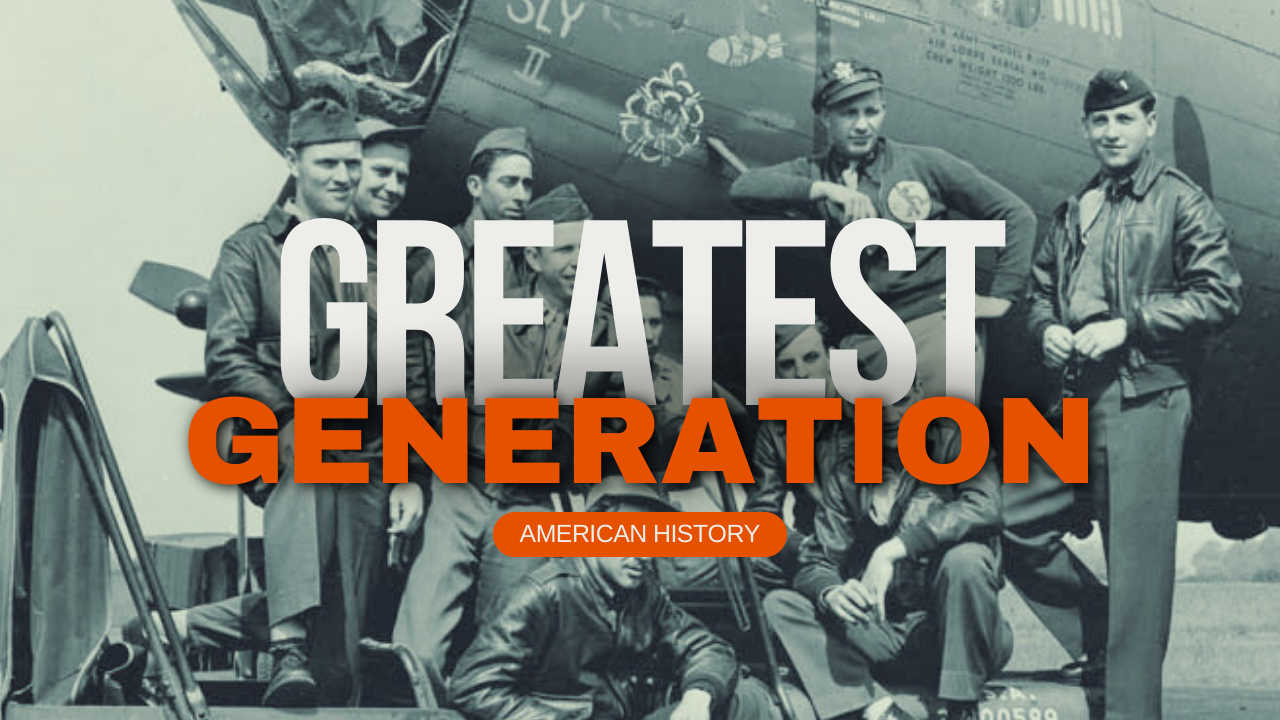The Greatest Generation

In the weeks following Pearl Harbor, the American nation mobilized for war, sending young men halfway around the world in all directions—to the European, Asian Pacific, North African and Mediterranean Theaters; each tasked with dramatically different fighting conditions. American men and women fought to liberate not only the occupied countries, but ultimately the oppressors themselves, Germany and Japan as well. When asked what it meant to be apart of the war effort, one veteran said that he felt like he had done his part in turning the twentieth century from one of darkness into one of light, while another said, “I was eighteen years old and had my whole life ahead of me. I have been taught the difference between right and wrong. And I didn’t want to live in a world in which wrong prevailed. So I fought.”
Nicknamed The Greatest Generation or GI Generation by Tom Brokaw’s 1998 publication of a book by the same name, Brokaw lauded the generation for their selflessness, dedication to duty, and unwavering commitment to the collective good. Drilling down on the demographics of the Greatest Generation, the Pew Research Center has defined the generation as being born between 1901 to 1927, the first half of the generation born between 1901 and 1912, while the majority of WW2 veterans were born from 1913 to 1924. For the earlier half of the Greatest Generation, many had grown up in the high cotton years of the Roaring Twenties and the Progressive Era, while nearly all of them lived through the Spanish Flu of 1919 and the Great Depression that dogged the nation until the onset of war.
Born to parents of the Lost Generation, the Greatest Generation experienced plenty of hardships during the hardscrabble days of the Great Depression, but they also grew up in an age of rapid technological advances, including radios, telephones and automobiles. In movie theaters across the nation, Hollywood had reached its golden age, with films like It’s a Wonderful Life, Gone With The Wind, The Grapes of Wrath, Citizen Kane and Casablanca. The Greatest Generation also had their signature music and dance during the Swing era of modern jazz, which became a cornerstone of their generation.
For those who fought in WW2, some had been farmers or coal miners. Others had been store clerks, teachers, truck drivers, lawyers, accountants and doctors. But what unified them as a common, single-minded force was their belief that they were locked in a primal battle between good and evil, caused by Hitler’s brazen assault on her peace loving neighbors and Hirohito’s unprovoked aggression, not only at Pearl Harbor, but across the entirety of Asia and the South Pacific basin.
Two days after Pearl Harbor, FDR yet again addressed an anxious nation.
Insert speech two
FDR’s words went straight to the hearts of Americans, reaffirming their common belief that they were locked in a crusade against tyranny, mayhem and oppression. FDR further stirred up patriotic resolve with his speech on the four freedoms that belong to every person in every part of the world.
Insert speech three
For those who fought, all four freedoms were not without a heavy price, during battles fought in nearly every corner of the world. Operation Torch in North Africa, Midway, Iwo Jima and Guadalcanal in the Pacific, Sicily’s Operation Husky and the invasion of Anzio in Italy. On June the 6th, 1944, the Greatest Generation undertook Operation Overlord, the largest amphibious landing in world history, before Allied forces began their long and bloody slog across the European continent.
Insert FDR speech four
“There is fighting every day,” one veteran recalled. “You can hear it down the road or in the distance. Sometimes, when it’s cloudy, you can’t tell where the sounds of the fighting are coming from, but they’re always there. The artillery booms, booms, booms, and then is answered by the echoes in the distant valleys, all sounding like heartbeats coming up from the earth. Sometimes, I’d swear that war is a living thing, huge and ugly, that eats up lives.”
While 16.1 million Americans served in the armed forces during WW2, Americans back home were equally involved in supporting the war effort. Americans of all ages rationed their food, bought war bonds and volunteered to send care packages to American fighting men overseas. It was a war effort like never before, where the courage, endurance and loyalty of American civilians played a vital role in winning the war.
Insert FDR Speech five
Insert Rosie
Insert How Detroit out built
When peace finally arrived, Eleanor Roosevelt wrote that “There is great happiness too, in the knowledge that someday soon many of those we love will be home again to give all they have to the rebuilding of the peaceful world. One cannot forget, however, the many, many people to whom this day will bring only a keener sense of loss. For as others come home, their loved ones will not return. In every community, if we have eyes to see and hearts to feel, we will for many years see evidences of the period of the war which we have been through. There will be men among us who all their lives, both physically and mentally, will carry the marks of war, and there will be women who mourn all the days of their lives. Yet there must be an undercurrent of deep joy in every day. There must be an undercurrent of deep joy in every human heart, and great thankfulness that we have world peace again. The greatest opportunity the world has ever had lies before us. God grant we have enough understanding of the divine love to live in the future as one world and one people.”
1950s
After the hardscrabble days of the Great Depression, the Greatest Generation’s all-in, can-do commitment to winning the war against tyranny brought about a time of booming prosperity on the home front, prompting former British Prime Minister Winston Churchill to proclaim that “America at this moment, stands at the summit of the world.” GI Generation soldiers returned home weary of adventure, with a unified desire to settle down into family life with their sweethearts, igniting a Baby Boom from 1946 to 1964 that recorded roughly four million births each and every year.
With the Greatest Generation now at the helm of American business and governance, the nation entered a golden age of American Capitalism that saw the doubling of America’s gross national product from 1946 to 1960, flooding a burgeoning middle-class with consumer goods and revolutionary home appliances like never before. Fueled by low-cost mortgages backed by the G.I. Bill, young couples flocked to new tract suburbs built by developers such as William Levitt, collectively earning the nicknames “Fertility Valley” and the “Rabbit Hutch” in light of the ongoing Baby Boom.
During their reign in post-war America, the Greatest Generation played a pivotal role in rebuilding the economy and shaping modern American values, institutions and infrastructure. Their unified sense of values—hard work, sacrifice, patriotism, humility and community, not only enriched the collective values of a nation, while their impact on later generations continues to inspire a sense of awe admiration for their resilience, sacrifice and unity in the face of darkness and oppression. However, as the members of this Greatest Generation continue to pass away, it becomes increasingly important to preserve their stories and honor their contributions to the foundations of freedom and democracy, making the Greatest Generation, a beacon of strength, during one of the darkest times in human history.
